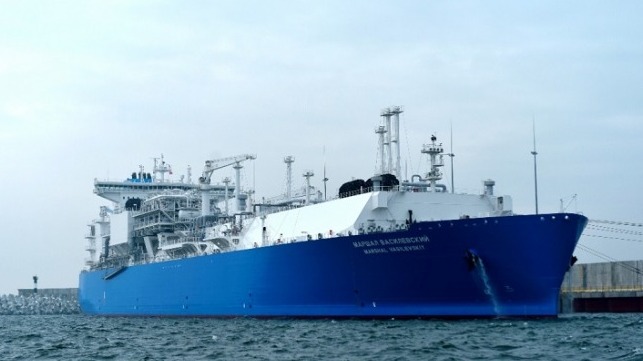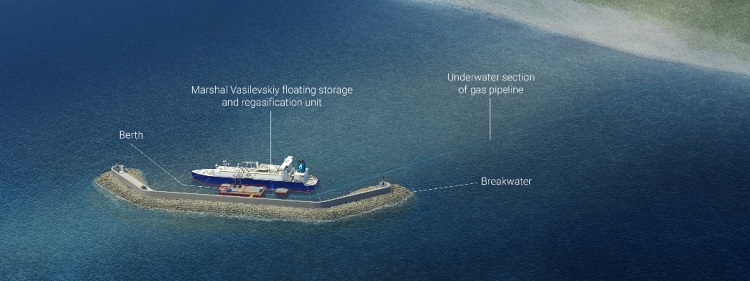FSRU Commences Operation at Kaliningrad

Russia's President Vladimir Putin inaugurated a LNG import terminal in Kaliningrad on the Baltic Sea earlier this week.
The facility is an offshore gas receiving terminal hosting the floating storage and regasification unit (FSRU) Marshal Vasilevskiy. The new facilities will enable up to 3.7 billion cubic meters of gas to be delivered by sea annually, enough to meet the current and future needs of the Kaliningrad region, says Gazprom.
The 174,000 cubic meter Marshal Vasilevskiy is the only FSRU in Russia. The FSRU has three regasification lines (including one backup line). The Arc 4 ice-class vessel has the capacity to independently navigate in ice with a thickness of up to 0.8 meters.
The regasification process starts at the FSRU as soon as the vessel is moored at the berth. Liquefied gas is converted to gaseous form and fed into the existing gas transmission system via a newly-built 13-kilometer pipeline.

The offshore terminal is a fixed marine berth with a breakwater, a first for Russia, and it is located five kilometers from shore in waters about 19 meters deep. The berth is a 125.5-meter monolithic slab of high-strength concrete resting on 177 piles. From the seaward, the berth is protected with a 728-meter C-shaped breakwater.
The breakwater designed to protect the berth has a complex structure, with 29 metal cylinders (20 meters in diameter, 21 meters in height, and weighing over 200 tons each) placed along the full length of the stone foundation that rests on the seabed. The cylinders are filled with rubble, and their outer surface has an anti-corrosion polymer coating. From the seaward, the cylinders are bolstered by a mound of rocks (weighing up to six tons each) and more than 20,000 special reinforced concrete blocks (tetrapods weighing from 7.8 to 25 tons).
The new facilities are an attempt to improve the reliability of gas supplies to the Kaliningrad region, says Gazprom. The company set up the Kaliningradskoye underground gas storage facility in 2013 and has since increased the throughput capacity of the Minsk – Vilnius – Kaunas – Kaliningrad gas pipeline, the only route for gas deliveries to the region until now.
The Kaliningradskoye underground facility, Russia’s first storage created in salt caverns, has a number of advantages over storage facilities made in depleted reservoirs or aquifers, says Gazprom. Salt caverns are ideal leak-proof containers as salt domes are fully impermeable to gas. It is possible to promptly switch Kaliningradskoye from injection to withdrawal and vice versa (multiple cycling capability), as well as to bring the facility to its peak performance in a short time.
At present, the Kaliningradskoye facility has four storage reservoirs in operation, with the working gas inventories of 174 million cubic meters. The gas storage is being expanded further and is expected to accommodate 800 million cubic meters by 2025.
Neighbours to Kaliningrad, Poland and Lithuania, have sought to reduce their dependence on Gazprom’s pipeline gas. The nations are among the E.U.'s most vocal opponents to the Gazprom-led Nord Stream 2 pipeline project.
